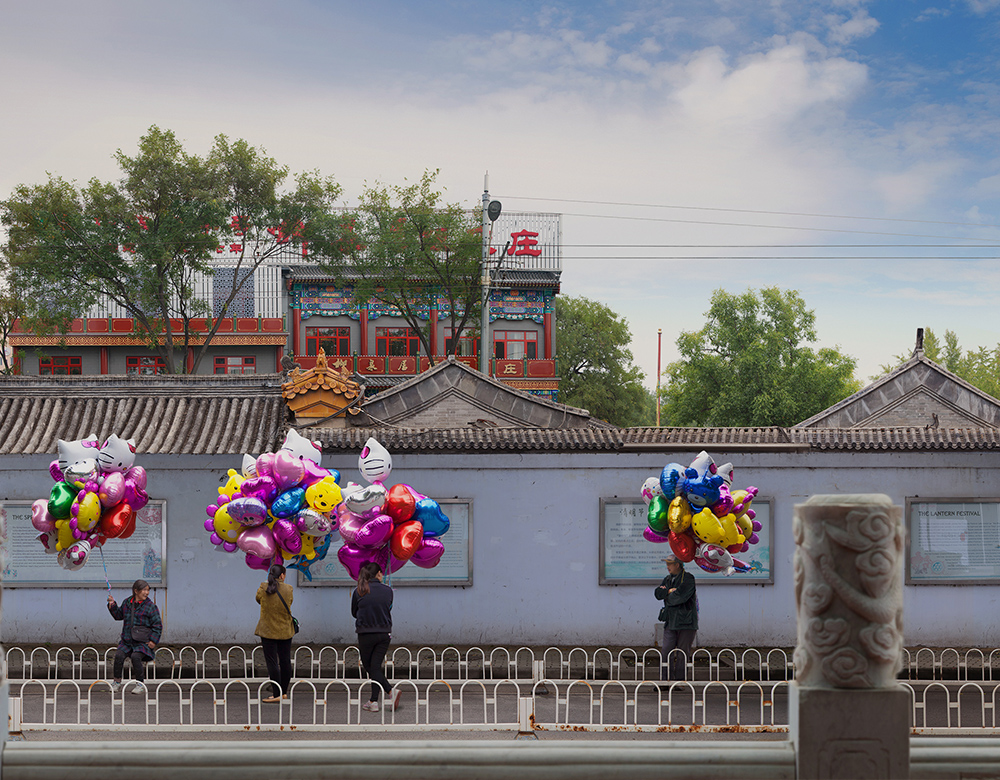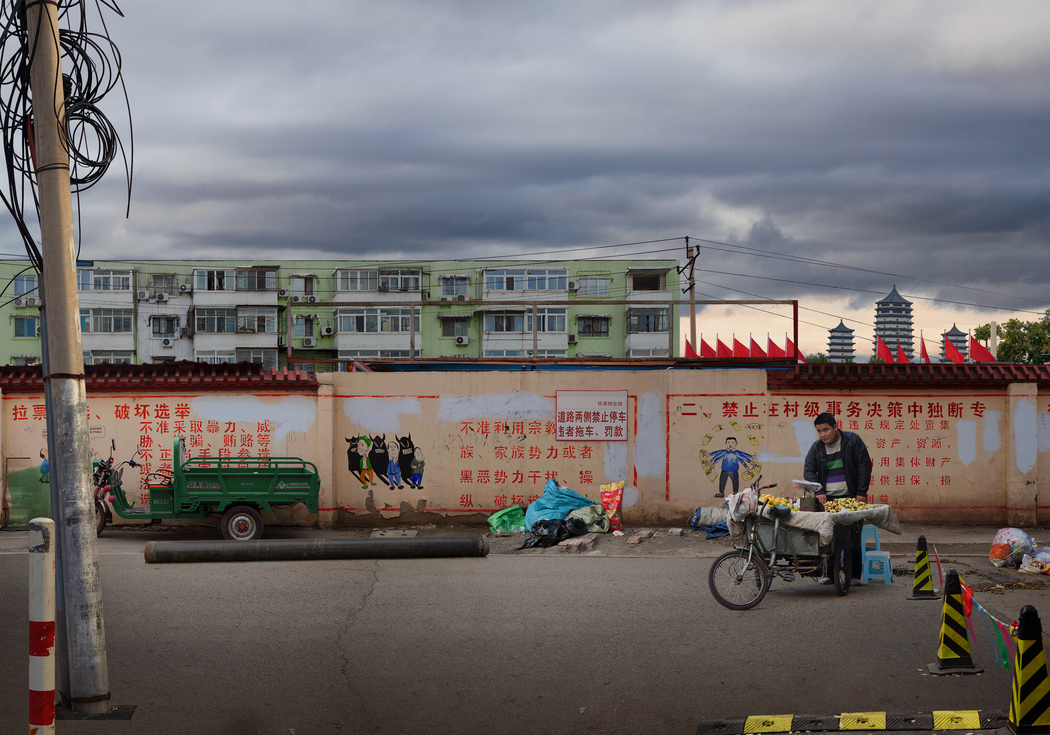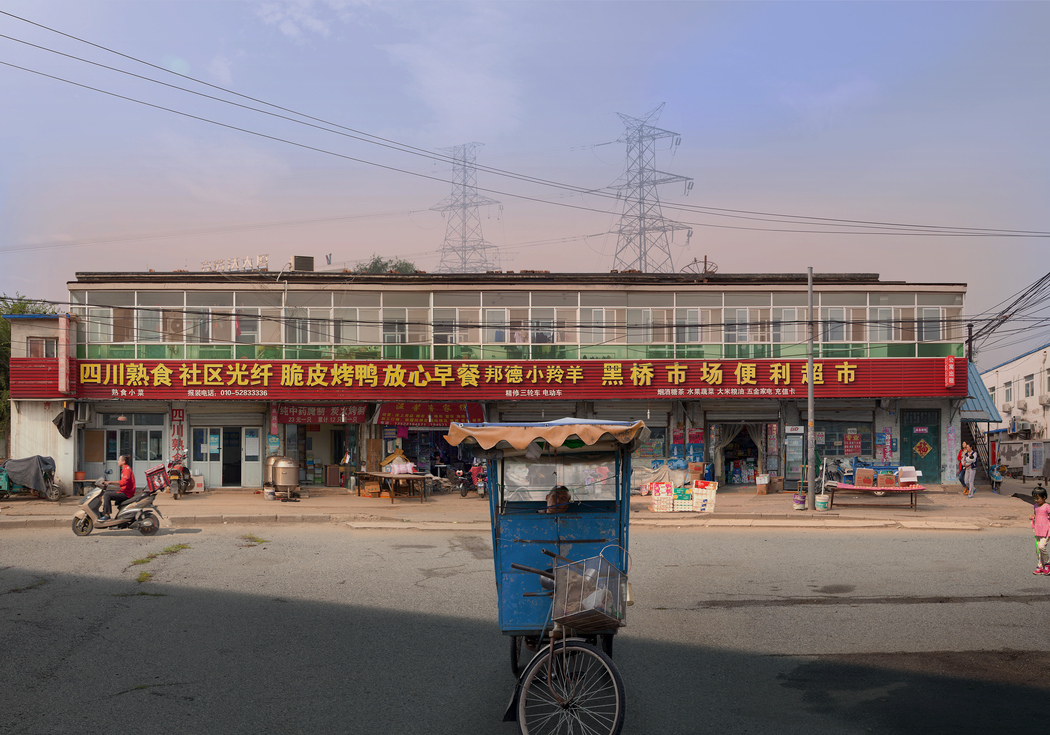Chung Chak
Where do you live: Pennsylvania, United States.
Your education: I have an MFA in Graphic Design. My training as a designer informs my interest in photomontage, as both involve solving visual problems to convey a message.
Website
 Chung Chak | Balloon sellers | 2023
Chung Chak | Balloon sellers | 2023
Your work explores the interaction between humans and their environment, especially through the lens of cultural clashes and alienation. Could you elaborate on how your personal experiences influence your creative process?
Let’s take my first series, Displacement, as an example. I started the project by taking “blind shots” of pedestrians walking in NYC. After printing these images in a relatively large size, I placed them into different locations within the city and photographed them again to create a final image. The project was centered around juxtapositions—displacing people from one location to another to highlight contrasts within the city they lived in.
As I wandered the city with a stack of thirty to forty of these prints, I relied on spontaneous intuition to match an image with the street scene in front of me. In essence, I was relocating individuals across spaces to make a social statement about class dynamics. Looking back, this process was a reflection of my own experience as a foreigner in New York—leaving behind my roots and adapting to an unfamiliar environment. It created an odd yet telling sense of belonging, or lack thereof.
A more recent example is my project Fragments of Reality. In this work, I was drawn to older parts of Beijing undergoing gentrification. I wondered how the relocated residents felt, and this resonated deeply with my childhood experience when the Hong Kong government moved my family from the city center to a remote area in the 1970s.
Your photomontages often present multiple layers of meaning. How do you approach creating these complex compositions, and what role does conceptualizing play in your work?
Some of my works are more complex than others, depending on the depth of meaning I want to convey in a series. For example, my 2008–2014 series, The Boxes, is one of the most layered projects I’ve created. It reflects my perception of different places and cultures—some aspects drawn from personal experience, while others incorporate stereotypes that may carry negative connotations for some viewers. Because culture is inherently complex, I used a “controlled chaos” approach to subtly convey my critique.
In my latest series, Whispers in the Dark, I explore the marginalization of Hong Kong society. To make my message more subtle and avoid overt offense, I incorporated complex layering techniques. Additionally, the visual density of the compositions reflects the overwhelming nature of Hong Kong’s urban environment.
When creating large-scale montages, I typically start by combining smaller images into segments, then integrating them in a way that feels intuitive yet structured—almost like solving a puzzle. Since each series consists of 15–20 images, I continuously refine the compositions to ensure cohesiveness. In many ways, my process feels like “painting with photo images.”
 Chung Chak | Two boys | 2023
Chung Chak | Two boys | 2023
You mentioned that you are inspired by the idea of the ‘low-end population’ as seen in Chinese media and your own experiences in Beijing. How do you believe the visual language of these murals and the social context they represent have influenced your work?
Having lived in both Chinese and American cultures, I’ve observed key differences in societal attitudes. Compared to Americans, Chinese people tend to be more accepting of authority and cooperative with their government. Even compared to my upbringing in Hong Kong, I noticed a distinct contrast. It certainly has its historical root from the Chinese philosophy about social orders
When I first encountered Beijing’s educational wall paintings, I found them humorous and beautifully crafted. However, I questioned their effectiveness. Over time, seeing them repeatedly made me realize they must serve a purpose—otherwise, they wouldn’t persist for decades.
Growing up in British-controlled Hong Kong, my education shaped a Westernized perspective on the relationship between individuals and society. Observing Beijing’s residents, many of whom seemed content with the economic prosperity brought by the government, influenced the aesthetic of my work. As a result, my photomontages feature vibrant colors, soft lighting, and a utopian atmosphere—even when depicting neighborhoods set for demolition. I wanted to capture the beauty of these communities, despite their economic limitations.
In your series The Walls (now renamed Fragments of Harmony), you use layering to create harmony. Could you discuss the concept of “seams and inconsistencies” in your images and what you hope viewers take away from these visual contradictions?
Many critics have been amazed by how seamlessly my photomontages are composed—some don’t realize they are montaged until I tell them. However, upon closer inspection, subtle inconsistencies emerge: shifts in perspective, variations in lighting, and slight color discrepancies.
These inconsistencies are intentional, and they are the direct result of the montage process. They symbolize the illusion of harmony within society—everything may appear cohesive at first glance, but deeper scrutiny reveals incontinence. My work reflects this tension, showing that the dominant narrative does not always represent every individual’s voices.
 Chung Chak | Fruit seller | 2023
Chung Chak | Fruit seller | 2023
As a street photographer, you thrive on discovering spontaneous inspirations. How do you balance the unpredictability of street photography with the more deliberate nature of your photomontage work?
I don’t see them as separate. Even in my photomontages, spontaneous ideas arise and shape the development of both visuals and content. This creative spontaneity fuels my process.
On the other hand, my street photography is not entirely impulsive—I always have an intention in mind. For example, I might wait at a street corner for minutes, anticipating the perfect moment when a passerby aligns with a specific billboard to reinforce a visual statement. Even in these moments of unpredictability, my choices are guided by experience and a conceptual framework.
Your work serves as both an homage to a specific neighborhood in Beijing and a reflection on the impermanence of urban spaces. How does this connection to place inform your artistic practice, and how does the destruction of this neighborhood impact the meaning of your work?
Our upbringing significantly shapes how we respond to new environments. I spent my first twenty years in a working-class neighborhood, where street vendors, cluttered markets, and communal gatherings were part of everyday life. My childhood memories are filled with images of old men playing chess in public parks at sunset, housewives hurrying through street markets, and the familiar aromas of home-cooked meals wafting through apartment windows.
Walking through Beijing’s soon-to-be-demolished areas evoked these memories. The nostalgic warmth of my upbringing influenced my photomontages, which often feature soft lighting and a dreamlike quality. Although my family was not wealthy, our community was tightly knit and full of life. My work serves as a romantic reflection of that time.
 Chung Chak | Blue rickshaw | 2023
Chung Chak | Blue rickshaw | 2023
Having exhibited your work internationally, what are some key reactions or insights you’ve received from audiences in different cultural contexts?
Most of my exhibitions have been in the U.S., with a few solo and group exhibitions in the U.K., Italy, and Spain. Since my formative years were spent in Hong Kong and my work often features locations outside the U.S., many American viewers perceive my art as “foreign.” This leads to different interpretations—some find the unfamiliarity intriguing, while others struggle to connect.
This is inevitable, and all artists must navigate the varying perspectives of their audiences.

Leave a Reply